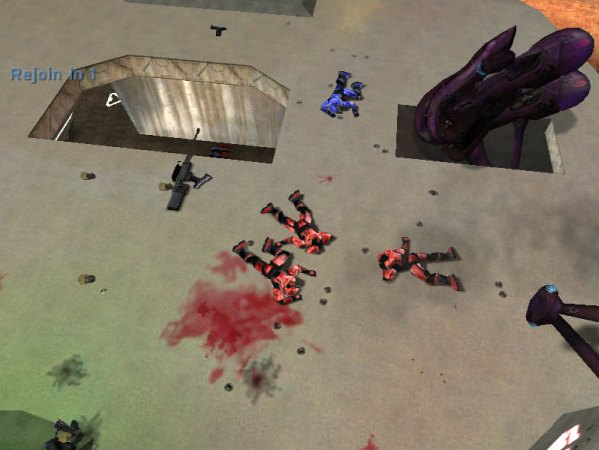
[tabgroup][tab title=”Redefining video games”] In order to sell, video games must contain amazing graphics, ear-ripping sounds and, in most situations,
blood. Activision, the creators of the “Call of Duty” franchise, said that it alone profited more than the “Harry Potter” franchise and the “Star Wars” franchise together, totaling more than $11 billion dollars.
This violence suggests that killing is a normal activity. Many have argued there is a connection between violent video games and teenage killing. There should be more studies executed to determine if there is a correlation.
The first video games were not made with any graphics or any sound, and today, many would probably not consider them to be video games at all. Thomas Goldsmith Jr. and Estle Ray Mann made the first game in 1947. They got the idea from the World War II military missile launcher screens and created a game that simulated shooting rockets at targets. However, 65 years ago, there were no such things as graphics, so they had to put a sticker with an X on the monitor to symbolize the target.
The next known video game was not designed to be fun, but to show people how intelligent machines were and what they could do. Between 1947 and 1958, Alan Turing created a “mate-in-two” chess game, which could only move two spaces and then stop. Today, even an amateur programmer could create those types of games. Games created in the past, however, are pertinent for games in this century.
In 1951, a man named Ferranti invented a computer named the NIMROD. Though it weighed more than a ton, it had only one task: to play Nim, a mathematical game. This was the first time anyone had created a computer game to play games on, and the NIMROD was presented at the Festival of Britain on May 5, 1951. Alexander S. Douglas created OXO, or Noughts and Crosses, in 1951 as well. It was the first video game created that used a digital graphic display. The remote for the game was a rotary telephone.
William Higinbotham created an interactive computer game in 1958 called Tennis for Two. It was made to promote atomic power and was on display for the Brookhaven National Laboratory’s annual visitor’s day.
Between 1957 and 1961, MIT created many interactive graphical programs using the TX-O experimental computer. One of the many games they made was called “Mouse in the Maze” and it allowed players to place maze walls along with dots in the maze, which represented either bits of cheese or glasses of martini. After they designed the maze, a computer-generated mouse would run through the maze and test it.
The variety of video games at this time did not exist 20 years ago. Some of the most popular types include shooter, survival, adventure, strategy, RPG and MMORPG games. Every year, the new games released have better graphics and sounds than they previously did. In shooter games, the graphics of the blood and death are becoming too violent for the children that play them, who vary in age from seven and up.
Avid gamers I spoke to admit they have gotten used to the idea that killing is OK after many months of play.
If violent games change the way 16-year-olds think, wouldn’t they also brainwash younger children to believe that killing people is normal; it will be fine, and the person will spring back to life after five seconds anyway?
Many recent massacres were linked to a person playing violent video games, causing many to believe there is a connection.
One example would be the Newtown, Conn. shootings in December 2012, which killed 20 children. The man behind the gun, Adam Lanza, spent hours playing violent video games in his dark basement. His games included countless guns, and he even owned some of the guns featured in those games.
His mother, Nancy Lanza, was a gun enthusiast whose family owned at least 12 guns. Every week, she took her two children, Adam and Ryan, to a shooting range to practice with those same guns.
“There are too many video games that celebrate the mass killing of innocent people – games that, despite attempts at industry self-regulation, find their way into the hand of children,” Sen. Chuck Grassley (R-Iowa) said.
It is possible that if Lanza had not played those violent video games, he would not have thought about killing those innocent children.
I am saddened that most of the video games created today are focused on killing. I truly love video games that don’t have that type of gore in them. It is becoming harder to play games without violence because the video game industries only create games that make the most amount of money, which are war games. I call this the “new era of video games,” which is truly redefining what a video game is.
Until 25 years ago, people made video games to prove that people could program computers and other hardware to do things that were never imaginable. Just like Alan Turing did with his “mate-in-two” chess game, designers created video games, showing the capability of machines.
Once industries like Atari and Nintendo noticed the potential, they tried to create profitable games. This led to the creation of video games for the sake of business, without thinking about the negative side effects the games would have on children’s minds. Even if children can’t see the consequences of the violent games, will they eventually realize what they did to their minds when they were younger?
I wish games could return to the time when the person holding the controller had power over the game. I wish we had never entered an era where games control people.
In order to lessen the number of violent video games, we should stop demanding them.
Video game creators will only design the games that produce the most profit, and we cannot change that. However, we can change what games make them money and discourage savage behavior. We must stop purchasing games that contain endless violence and gore. Hopefully, this will cause the video game industries to produce enjoyable non-violent games.
Written by Abdul-Rahman Abdul-Kafi

[/tab][tab title=”Blame the parents, not the games”]
Since the Columbine massacre in 1999, pundits have blamed ‘violent’ video games for affecting children’s minds because an investigation discovered that shooters like Eric Harris and Dylan Klebold enjoyed “shoot ‘em up” video games.
Just this winter, video games were the target of inquiry during the investigation of the Sandy Hook shooting in Newtown, Conn., which found that the perpetrator, Adam Lanza, owned and played video games. This led National Rifle Association (NRA) president Wayne LaPierre to blame video games for the shooting.
Interviews after the shooting show that Lanza was a socially fragile boy captivated by warfare video games and intent on military service. However, a few months after the shooting, former Federal Bureau Investigation profiler Mary Ellen O’Toole said she believes video games don’t cause violence.
During a panel discussion on February 24, O’Toole said evidence did not support that theory.
“It’s my experience that video games do not cause violence,” O’Toole told CBS News. “It’s important that I point out that as a threat assessment and as a former FBI profiler, we don’t see these as the cause [of] violence. We see them as sources of fueling ideation that’s already there.”
Despite O’Toole’s statements, the NRA jumped at the chance to blame video games for inspiring young people’s aggressive behavior to avoid the public’s cry for stricter gun control laws.
Parents should be at the forefront of change. For example, the late Nancy Lanza, Adam’s gun-loving mother, should have had second thoughts about buying ‘violent video games’ for her mentally unstable child.
Christopher Ferguson, a psychology professor at Texas A&M International University, stated that youth violence had recently declined to the lowest level in 40 years at a time when video games had become more violent. In his opinion piece on the CNN website, he described the reaction as a moral panic.
“It’s worth asking ourselves why we keep returning to video games despite the lack of evidence to support its link to violence,” Ferguson said. “Of course, this kind of association is not new. Some scholars blamed television for the crime wave of the 1970s and ‘80s, which has since vanished. And comic books in the 1950s were blamed by psychiatrists for not only delinquency but homosexuality. In hindsight, these strands of associations look ridiculous, but in the moment they served a purpose.”
Henry Jenkins, an MIT media scholar, debunked myths surrounding video games. Much like Ferguson, he believes moral panic about violent games is harmful and could lead adult authorities to be more hostile to many kids who already feel cut off from the system.
He believes the hostility can also misdirect energy away from eliminating the actual causes of youth violence and instead allows problems to continue. He pointed out that no research has found that games are a primary factor that could turn a person into a killer.
Ferguson also mentioned that weeks after the shooting, there were high-profile crimes committed by older men. These criminals never fit the video game player stereotype.
Video game ratings exist to inform parents of the game’s content. Unfortunately, parents often ignore these warnings provided by the Entertainment Software Rating Board. Furthermore, they aren’t aware of their child’s mental stability.
Professor Jenkins is right; there should be more strict marketing that targets young consumers accustomed to mature content and educates parents about the media choices they face. It is the parents’ responsibility to make decisions about what’s appropriate for their children. Bad parenting is to blame for child delinquency, which leads to this kind of school shooting.
“Most children who commit violent crime show an early combination of personality and family factors that include having trouble getting along with playmates in preschool,” Robert Butterworth, a Los Angeles-based psychotherapist, said. “By second or third grade they’re doing poorly in school, and have few friends. By the age of 10 they’re picking fights and getting labeled by their peers as social outcasts. They typically come from families where parents are poor at disciplining because they are indifferent, neglectful, too coercive or they use harsh physical punishment with little love.”
Sure, guns don’t kill people. Sure, video games don’t create violent acts. But, bad parenting makes children into monsters. Bad parents are the ones to blame for school shootings in America, not video games.
Written by Jay Whang













































































